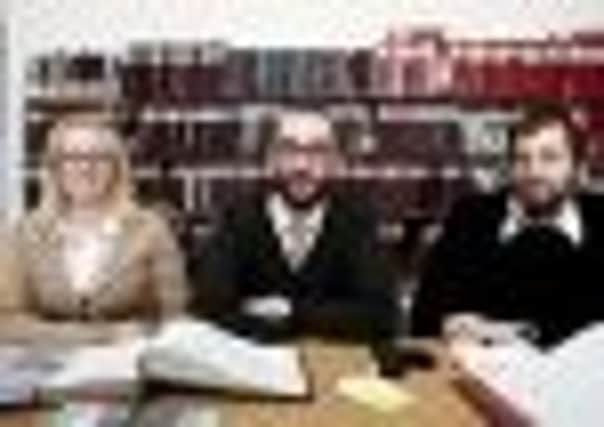Shelf sufficiency: Archives lead to new idea


THE sound of contemporary Scottish music and long-forgotten recordings of the country’s folk past combine in this month’s Archive Trails tour, a collaboration between Glasgow-based concert promoters Tracer Trails, the School of Scottish Studies at the University of Edinburgh and three artists whose work neatly serves both past and present. Over the course of three months, Alasdair Roberts, Drew Wright (aka Wounded Knee) and Aileen Campbell were given access to the school’s archive, and this live tour will showcase the trio’s own musical responses to what they heard.
“The archive consists mostly of field sound recordings,” says Emily Roff, Tracer Trails’ promoter, alumnus of the School’s Scottish ethnology course and “curator, producer and general dogsbody” of Archive Trails. “These were made by ethnographers, geographers, linguists of all sorts: people like Hamish Henderson, who was a massive figure in the folk revival in Scotland, Calum MacLean, the brother of the Gaelic poet Sorley MacLean, and Alan Lomax, the American folklorist.”
Advertisement
Hide AdAdvertisement
Hide AdThis is the year of the archive’s 60th anniversary (it’s also Tracer Trails’ fifth birthday). Although it was influential in the Scottish folk revival of the 1950s and 60s, the freely available resource doesn’t see as much use now as it did at its inception. Archive Trails’ intention, then, is partly to recast a light upon the archive, echoing its original purpose.
“There are recordings of traditional songs and tales in the archive,” says Roff, “and also photographs and recorded oral histories and reminiscences, all of ways of life that existed in Scotland in the 1950s and 60s that have now been lost. And [the archivists] knew that at the time, they knew these practices were dying out, so it was really a process of trying to collect them in these different media.”
Her own background as a promoter and the predominantly audio basis of the source material helped Roff arrive upon the format for this original music commission; past work with both Roberts and Wright gave her ideas as to how it could be honed.
“I’m really interested in the way Alasdair and Drew take traditional texts and materials, and work them into something that’s much more contemporary and radical,” she says.
On the other hand, Campbell, a visual artist, is “interested in song and the human voice more generally, which I think is really relevant to the archive as a whole, to the idea of collecting people through recordings of their many different voices and dialects.”
Roberts’s piece is an update of the late 19th and early-20th-century Borders folk play Galoshins, a continuation of the singer’s practice of using traditional texts within his own material. A seasonal drama staged by children on Old Year’s Night or Hallowe’en, the piece has been rescripted in an extended form by Roberts and, says Roff, “combined with an initiation rite for a farmhands’ secret society which existed in the North-east of Scotland up until the mid-20th century.” Roberts’ piece also involves puppet work by Shane Connolly.
Wright and Campbell’s works are more formal in nature, with the latter examining the way songs are learned in an improvisational piece, which will see her actually learn a new song and discuss the process of doing so every night. Wright, meanwhile, describes “fumbling about at first due to the sheer quantity of material” and of “loading up the old reel-to-reel tapes, which was fun until you realised it was much easier just to get everything streamed to a computer”.It was a similar commission, from the Glasgow Short Film Festival to create a piece from the Scottish Screen Archive, which eventually brought things together for him.
Advertisement
Hide AdAdvertisement
Hide Ad“I researched herring fishing in the East Neuk of Fife, these interviews with fishermen who had worked towards the end of last century. This was all working towards adapting Ewan MacColl’s song Shoals of Herring and transposing the narrator from Yarmouth to the East Neuk, so I was listening out for the names of fishing grounds and boats, the terminology these men might have used, anything which might relocate the song.”
Discovering more “happy accidents, songs that stopped me in my tracks while I was searching for something else,” Wright will be inviting the audience to play a kind of game of bingo with a repertoire of his own tracks and archive songs he’s learned.
“I think this archive is really important as a resource for understanding Scotland’s history,” says Roff, “and it’s also underused, so the point of this project is really to shine a bit of light on it and let people know it’s there.”
She speaks compellingly of the collected works in the archive, of recordings from the Scots diaspora in Canada and Appalachia and of the John Levy collection of folk music in the Far East: “that’s really amazing”; and while she doesn’t believe Archive Trails will happen again in its current format, she does see Tracer Trails both working with the archive and creating more long-term commissioned projects. The point being that inspiration awaits anyone, musician or otherwise, who wishes to experience the archive for themselves.
lArchive Trails is at the Cupar Arts Festival, today; Scottish Storytelling Centre, Edinburgh, tomorrow; Old Bridge Inn, Aviemore, 17 October; An Tobar, Tobermory, 18 October; The Achness Hotel, Rosehall, 19 October; and CCA, Glasgow, Friday 28 October. For more information visit www.archivetrails.com